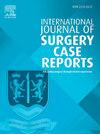Quadriceps tear, infection and dislocation: Three rare complications after total knee arthroplasty. A case report
IF 0.6
Q4 SURGERY
引用次数: 0
Abstract
Introduction
Infection after a total knee arthroplasty (TKA) is one of the most severe complications, with an incidence that ranged from 0,5 % to 1,8 %, while the incidence of a quadriceps tendon tear after total knee arthroplasty range from 0.1 % to 1.1 %. Dislocation of a TKA is another rare but very serious complication with an incidence of 0.5 %. After all, the association of these three complications, that quickly occur together, is extremely rare condition.
Presentation of case
Ninety years old man underwent to TKA for right knee osteoarthritis. During rehabilitation, the patient had quadriceps tendon rupture and underwent to tenorrhaphy. Three months after tenorrhaphy, on suspicion of infection, the patient received a surgical debridement. At this time total knee prosthesis was well fixed and was not removed. After another five months, the patient felt again and the radiographs of the right knee showed a posterior dislocation of the TKA treated by closed reduction in operating room, under general anesthesia. At the latest follow-up, clinical and radiological examinations showed good alignment of the TKA prosthesis, without loosening and good functional capacity.
Discussion
Orthopedic surgical treatment in an elderly patient could expose to many complications. We could speculate that musculo-tendinous lesion and infection favored the TKA dislocation.
Conclusion
Infection, tendon injuries and dislocation are serious complications after TKA. Poor outcomes are often described for each of these complications in the current literature, however our patient recovered a good quality of life after treatment, despite the complexity of these complications and the old age.
求助全文
约1分钟内获得全文
求助全文
来源期刊
CiteScore
1.10
自引率
0.00%
发文量
1116
审稿时长
46 days

 求助内容:
求助内容: 应助结果提醒方式:
应助结果提醒方式:


